 |
||
|
||
| ||
Contents
Technical propertiesAlthough relatively new to the market, Scythe, which first began its United States business operations in 2004, has already introduced a number of products that have been quite popular among PC enthusiasts. To secret to Scythe's success is a pretty simple formula; offer a product with a simple design that offers solid performance. Although many of Scythe's product aren't as flashy as other manufacturers, its high-class coolers are able to compete with leading products from Cooler Master, Thermaltake, and Zalman. In recent years Scythe has undergone rapid expansion, an achievement that can be attributed to the companies' successful strategy. Scythe has grown into a leading company in the PC cooling industry due to it aggressively creating new products for both the high-end and entry-level markets and by carefully choosing the price of its products. Today we are taking a looking three top model from Scythe: the Ninja Plus Rev.B, the Infinity, and the Andy Samurai Master. Ninja Plus Rev.B (SCNJ-1100P)Our review starts with the Ninja Plus Rev.B (SCNJ-1100P), the successor to the well-configured and legendary Ninja cooler. 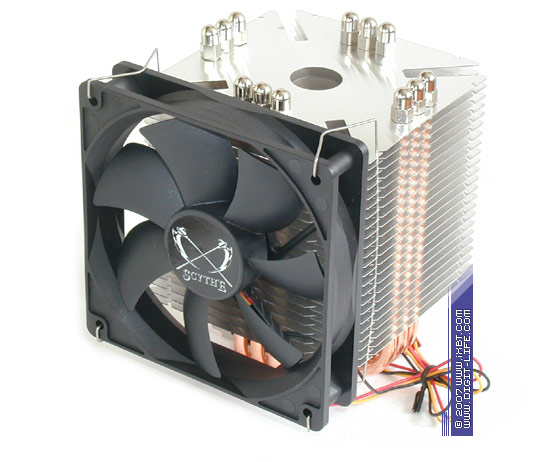 The design of the Ninja Plus Rev.B is almost exactly the same as its forefather. It is based on the same "tower" layout and consists of six copper heat pipes, each of which is 6 mm in diameter, and a section of 23 aluminum fins (approximately 0.4 mm thick, 110x110 mm). The heatsink is spiced up with a thermal bonificator, which is an aluminum 65x54x25 mm heatsink that is attached to the base of the cooler in order to offload heat from the hottest parts of the heat pipes and channel more heat from the main fin section. 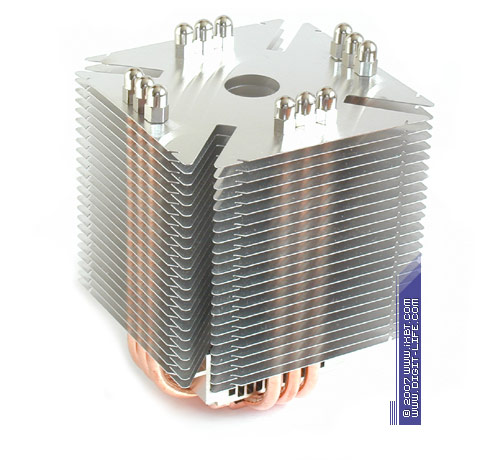 The new cooler also inherits all of the technical traits of the Ninja series. In the first place, just like previous versions of the cooler, the Ninja Plus Rev.B has an interesting fin configuration. The fin configuration is designed to minimize hydraulic resistance of the heatsink and increase the heat transfer efficiency - fins with four diagonal cut-outs and one central cut-out, a longer fin step (4 mm). 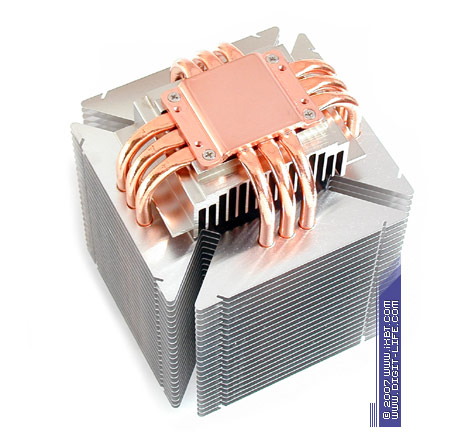 The heat exchange surface is also quite good and is 4500 cm2. This is especially impressive considering the already present heat exchange elements on the cooler. The increased number of contact segments between the fins and heat pipes creates 12 heat exchange elements. This also combines with optimized finning allowing the use of almost the entire surface of the Ninja Plus Rev.B for heat exchange. We should also mention that the heat pipes are joined quite solidly with the fins through quality soldering, ensuring thermal contact and reducing the overall thermal resistance of the cooler. 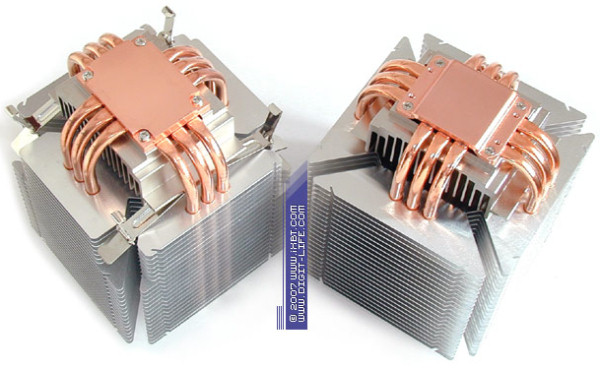 Ninja and Ninja Plus Rev.B Heatsinks Perhaps the only new feature in the Ninja Plus Rev.B (compared to the Ninja and Ninja Plus) is its support for Socket AM2 - the cooler is equipped with a modified heatsink (50x38 mm, 32x38 mm base) and a modified retention module (supports Intel Socket 478, LGA775 and AMD Socket 754/939/AM2). 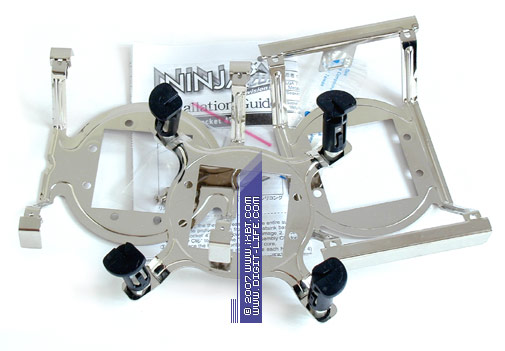 This new retention module not only expands compatibility of the cooler, but at the same time also noticeably improves the installation experience of the new Ninja cooler over previous versions. You don't have to remove the motherboard from the PC case when you install the cooler on LGA775 sockets. All that is required is for installation is to place the retention bracket on the base using four screws and fix the heatsink in place with the standard mounting clips; after that, the cooler is installed. It isn't any more difficult installing the cooler on AMD-based motherboards; just take the AMD retention bracket, screw it to the base, and latch the cooler using the levers to the socket. From every viewpoint the installation process isn't difficult, even for beginners. Infinity (SCINF-1000)The next model in our test list is Scythe's flagship cooler, the Infinity (SCINF-1000). 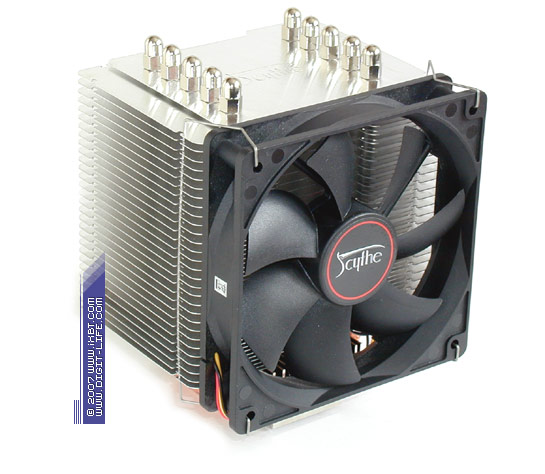 The Infinity is an advanced cooler - it is formed by large aluminum fins (125x90x108 mm), 5 copper heat pipes (6 mm in diameter), and a copper heatsink (52x45x2 mm). An auxiliary aluminum heatsink added to the base (57x78x27 mm, 36x78 mm at the base) acts as a thermal bonificator that offloads parts of the heat pipes picking up the heat. 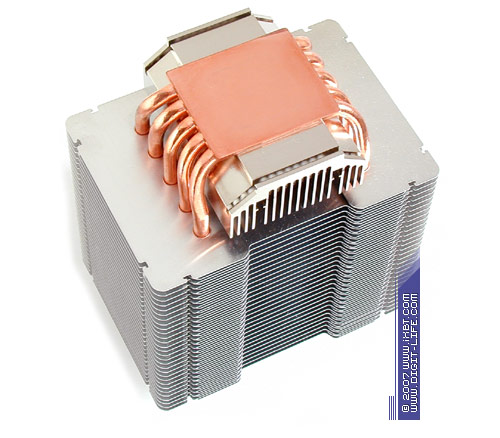 The highlight feature of this model is its unique Infinity Interleave Fin Structure. This feature divides the fins into three interpenetrating sections (one central and two side sections). The central section comprises of 29 aluminum fins (95x90 mm, 0.3 mm thick, at 3.5 mm steps) and thermally connects all heat pipes (10 heat exchange elements). The side sections consist of 29 fins (40x90 mm, 0.3 mm thick, at 3.5 mm steps) and contact only five heat pipes and intermit with the end fragments of the central finning section. 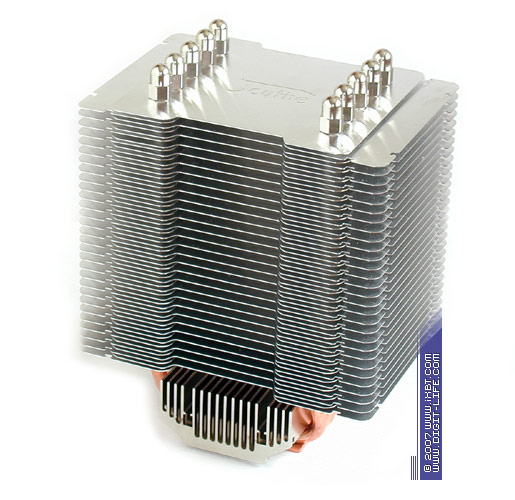 As a result of this feature, the Infinity solves two large problems in an elegant manner. The cooler raises efficiency of the heatsink and minimizes hydraulic resistance - heat exchange intensity grows due to denser finning on pipe segments designed to release the heat (there are twice as many fins in these segments). In addition, wide fin steps in the central part guarantee excellent air penetration even with a weak fan. The advanced design of this cooler also improves its thermal parameters: the total heat exchange surface area in the Infinity is raised to an incredible 9000 cm2 - this is an absolute record among high-end coolers tested in our lab! 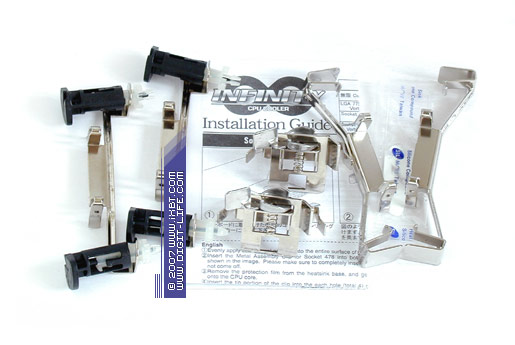 The Infinity is also easy to install. The cooler comes equipped with a very friendly retention module (it supports Intel Socket 478, LGA775, and AMD Socket 754/939/AM2) which ensures quick and painless installation. In fact, you can install the cooler in only a few seconds without a screwdriver. Installation only requires users to latch the corresponding mounting brackets to the heatsink grooves, secure the retention module in the socket (with special assembly clips, they are different for AMD and LGA775), and then secure the retention module in the socket (with special assembly clips, they are different for AMD and LGA775). The Infinity definitely outscores the Ninja Plus Rev.B in ergonomics and installation ease. Despite its imposing weight (about 980 g) and dimensions, its dimensions and weight is actually on par with standard box coolers. Andy Samurai Master (SCASM-1000)The last cooler we are reviewing is a new product from Scythe; the Andy Samurai Master from Scythe. 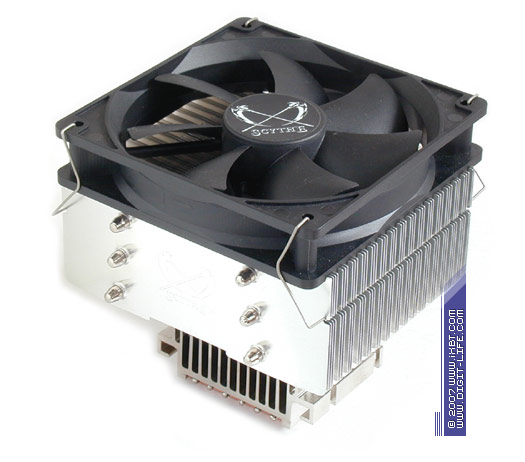 Unlike the Ninja Plus Rev.B and Infinity, the Andy Samurai Master is based on a different ideology - instead of the vertical, tower-like design, the fins are arranged horizontally, parallel to the base (a la Big Typhoon). For this reason, the heatsink is more compact (125x102x50 mm). The Andy Samurai Master still does have some features in common with the other two Scythe coolers. Like the other coolers, this cooler also sports an advanced set of features: aluminum fins of a complex configuration, six copper heat pipes (6 mm in diameter), a copper base (52x50x2 mm), and an auxiliary aluminum heatsink (56x50x48 mm) connected to the heat pipes. 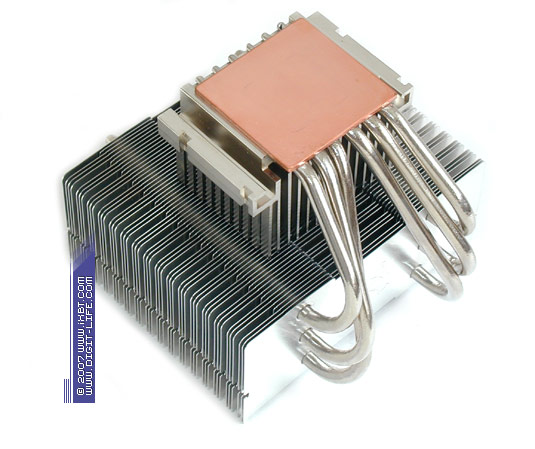 The highlight feature of the Andy Samurai Master is its individual tri-section configuration of finning in compliance with the Infinity Interleave Fin Structure. The central section acts as a heatsink base and consists of 49 fins (125x50 mm, 0.2 mm thick). Two additional sets of fins (16 pieces, 25x50 mm) are inside the main section and are connected to the corresponding heat pipes for thermal intensification of all six heat dissipation elements. The heat exchange surface area is also impressive - over 7000 cm2. This means that the Andy Samurai Master competes with many High-End coolers, according to its heat exchange surface size, including coolers like the Big Typhoon from Thermaltake. 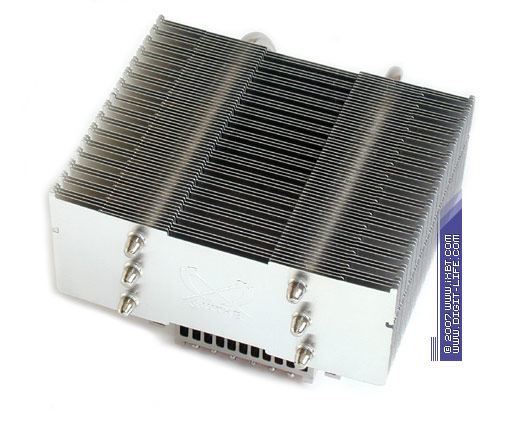 Installation is also a neat job for the cooler. It comes with a multi-platform mounting mechanism which guarantees quick and hassle-free installation on all supported platforms (Intel Socket 478, LGA775 and AMD Socket 754/939/AM2). Another advantage of the Andy Samurai Master is its reasonable weight (about 700 g) and dimensions. Unlike the Infinity, which has limited compatibility with some computer cases, the Andy Samurai Master is about 3 centimeters shorter and easily fits into any typical ATX case.  Contents
Vitali Crinitsin (vit@ixbt.com)
August 4, 2007 Write a comment below. No registration needed!
|
Platform · Video · Multimedia · Mobile · Other || About us & Privacy policy · Twitter · Facebook Copyright © Byrds Research & Publishing, Ltd., 1997–2011. All rights reserved. |